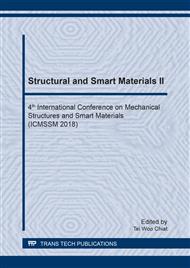p.75
p.81
p.87
p.95
p.100
p.105
p.113
p.119
p.124
Influence of Graphene Nanoplatelets on Silica-Filled Natural Rubber Composites: Dispersion Mixing and Effect on Thermal Stability, Rheological and Mechanical Properties
Abstract:
In this study, graphene nanoplatelets C750 (GnPs-C750) was introduced to silica-filled natural rubber composites (NR/SiO2/GnPs) by simple latex mixing process and coagulation following conventional vulcanization process to investigate the outstanding properties compared to individuals. The SiO2 and GnPs contents were fixed at 40 and 2 parts per hundred of rubber (phr), respectively. The results showed that in the presence of GnPs in SiO2-filled natural rubber composites, the thermal stability of the composite was improved. Meanwhile, the rheological properties including minimum torque and maximum torque were increased and cure characteristics including scorch time and optimum cure time were decreased related to cure rate index was greater than SiO2 individual. The influence of GnPs on the mechanical properties was investigated. The results showed that it was not significantly changed in mechanical properties.
Info:
Periodical:
Pages:
100-104
Citation:
Online since:
January 2019
Authors:
Price:
Сopyright:
© 2019 Trans Tech Publications Ltd. All Rights Reserved
Share:
Citation:


